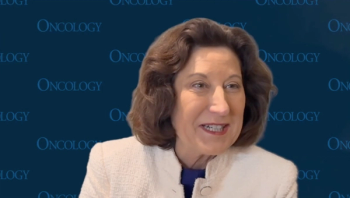
Oncology NEWS International
- Oncology NEWS International Vol 13 No 2
- Volume 13
- Issue 2
Adding Rituximab to CHOP Chemo Improves DLBC Lymphoma Outcomes
SAN DIEGO-The addition of rituximab (Rituxan) to CHOP chemotherapy has resulted in a dramatic improvement in outcome for patients of all ages with diffuse large B-cell (DLBC) lymphoma in a retrospective study from British Columbia. Improvements were greatest among the elderly population in the study, Laurie Sehn, MD, clinical assistant professor, British Columbia Cancer Agency and University of British Columbia, said at the 45th Annual Meeting of the American Society of Hematology (abstract 88).
SAN DIEGOThe addition of rituximab (Rituxan) to CHOP chemotherapy has resulted in a dramatic improvement in outcome for patients of all ages with diffuse large B-cell (DLBC) lymphoma in a retrospective study from British Columbia. Improvements were greatest among the elderly population in the study, Laurie Sehn, MD, clinical assistant professor, British Columbia Cancer Agency and University of British Columbia, said at the 45th Annual Meeting of the American Society of Hematology (abstract 88).
She said that in 2000, GELA (Groupe d’Etude des Lymphomes de l’adult) reported the results of a randomized controlled trial showing improved outcome with the addition of rituximab to CHOP chemotherapy for elderly patients with DLBC lymphoma.
New Policy
"Based on these initial results, the British Columbia Cancer Agency implemented a new provincial policy on March 1, 2001, recommending the combination of CHOP and rituximab for all newly diagnosed patients with advanced-stage DLBC lymphoma," Dr. Sehn said. "We are presenting a population-based retrospective analysis comparing outcomes over a 3-year interval."
The study ran from September 1, 1999, through August 31, 2002: 18 months prior to (pre-Ritux) and 18 months following (post-Ritux) this policy change. The cases were identified from three sources: the British Columbia Provincial Cancer Registry, the British Columbia Cancer pharmacy records, and the Lymphoma Clinical Database.
Patients were included, Dr. Sehn said, if they were older than 16 years of age; had a biopsy-proven newly diagnosed DLBC lymphoma; had clinically advanced-stage disease (stage III-IV; stage I-II with B symptoms or bulky tumors, or a contraindication to radiation) or testicular DLBC (any stage); and were treated with an anthracycline-based regimen with curative intent.
Dr. Sehn noted that cases were excluded if they were HIV positive; had CNS involvement; had evidence of transformation from indolent lymphoma; were never treated due to frailty, refusal, or rapid clinical deterioration; or received therapy with only palliative intent.
294 Patients
Researchers identified 294 patients, of whom 142 were pre-Ritux and 152 were post-Ritux. The patients ranged in age from 19 to 86 (median, 63).
Other patient characteristics included low International Prognostic Index (IPI) score (24%), low-intermediate IPI score (24%), high-intermediate IPI score (25%), high IPI score (27%), elevated LDH (65%), and bulky disease greater than 10 cm (42%).
Dr. Sehn said there were no significant differences in age, IPI distribution, serum LDH, or presence of bulky disease between the pre-Ritux and post-Ritux groups.
Although the policy implementation date recommending the use of rituximab was March 1, 2001, in actuality 9% of patients in the pre-Ritux group received rituximab with chemotherapy, compared with 85% in the post-Ritux group. More patients in the pre-Ritux group received radiation therapy (25% vs 15% post-Ritux, P = .04).
The median follow-up for living patients is 34 months for the pre-Ritux group and 17 months for the post-Ritux group.
Survival Results
Among all patients, 2-year progression-free survival was 52% pre-Ritux and 71% post-Ritux (P = .0009) (see Figure). Among those aged 60 or older (n = 167), 2-year progression-free survival was 44% pre-Ritux and 73% post-Rutux (P = .0018), compared with 60% and 70%, respectively (P = .18), for those under age 60 (n = 127).
Two-year overall survival pre- and post-Ritux was 53% and 77%, respectively, for all patients (P = .0001); 40% and 67% for those age 60 or older (P = .0033), and 69% and 87% for those under age 60 (P = .018).
In multivariate analysis controlling for age, IPI score, and B symptoms, pre-Ritux or post-Ritux treatment remained a strong, independent predictor of outcome (P = .002).
Articles in this issue
almost 22 years ago
Adjuvant Docetaxel Bests FAC in Breast Caalmost 22 years ago
BP1 Expression May Be Indicator of Early Breast Canceralmost 22 years ago
Bexxar: Low Risk of Secondary MDS/AMLalmost 22 years ago
Doubling Imatinib Dose Ups CML Response RatesNewsletter
Stay up to date on recent advances in the multidisciplinary approach to cancer.

















































































